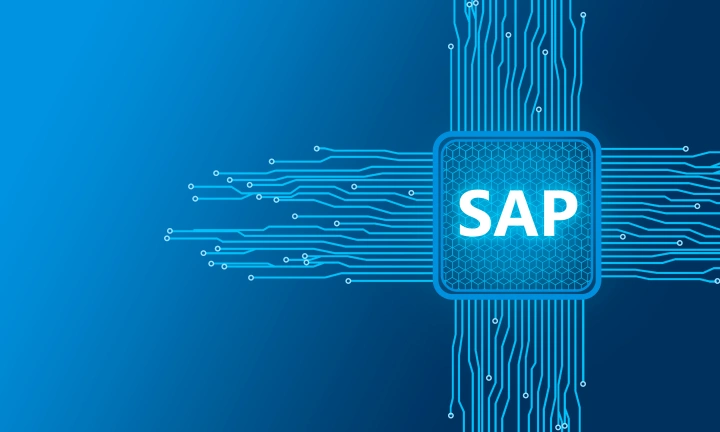SAP S/4HANA was developed by SAP SE as an advanced business solution, essentially succeeding the SAP Business Suite. It aims to integrate ERP, BI, and IoT platforms, providing innovation, high performance, and a comprehensive solution for users. For those using the SAP Business Suite, there’s an optional transition step called SAP Business Suite on HANA, where the HANA database replaces older relational databases. The goal is to offer users a more efficient and forward-looking system for their business needs. SAP S/4HANA architecture along with its components, is built to provide real-time insights, simplify processes, and enable a digital transformation for businesses.
Overview of SAP S/4HANA Architecture
Source: https://ur4-tia.com/
SAP Fiori: SAP Fiori is the user experience (UX) design approach used in SAP S/4HANA. It provides a responsive and intuitive user interface for accessing and interacting with SAP applications across various devices.
SAP HANA Database: The in-memory database, SAP HANA, is a fundamental component of SAP S/4HANA technical architecture. It enables the processing of large volumes of data in real time, which supports faster analytics, reporting, and transaction processing.
SAP NetWeaver: SAP NetWeaver is the technology platform that serves as the foundation for SAP S/4HANA architecture. It includes various components like the Application Server ABAP (AS ABAP) and the Application Server Java (AS Java) for supporting both ABAP and Java-based applications.
SAP Cloud Platform: SAP S/4HANA can be deployed on the SAP Cloud Platform, providing cloud-based services and enabling integration with other SAP S/4HANA cloud architecture solutions.
SAP Business Suite: The core functional modules of SAP S/4HANA include Finance (SAP S/4HANA Finance), Logistics (SAP S/4HANA Supply Chain, Manufacturing, and Procurement), and other industry-specific modules.
Integration with SAP Analytics: SAP S/4HANA integrates with SAP Analytics solutions for advanced analytics and business intelligence capabilities. SAP S/4HANA architecture diagram includes tools like SAP Analytics Cloud for data visualization, reporting, and predictive analytics.
Extensibility: SAP S/4HANA allows for customizations and extensions through SAP Fiori apps, SAP HANA Cloud Platform, and other tools to meet specific business requirements.
What are the Modules of SAP S/4HANA
For users navigating the SAP GUI to manage tasks like production orders and materials in the SAP S/4HANA implementation, the experience remains familiar. The menu structure and functions are similar to the classic modules, assuming the functionalities have transitioned to S/4HANA.
However, the SAP S/4HANA architecture overview has changed. In the S/4HANA world, SAP will use Lines of Business (LoB) to define functionalities. This shift is reflected in SAP tools like BP Explorer and Fiori Apps Reference Library. Instead of grouping innovations within modules, SAP will categorize them into business areas such as finance or manufacturing.
Although the classic modules still exist in the menu and application components, SAP will use new terminology to delineate functional areas. In essence, the traditional ERP modules will be replaced by these business areas (lines of business) in the S/4HANA system.
Source: https://ur4-tia.com/
In the updated classification system of SAP S/4HANA, the following functional domains are identified, as outlined in the SAP Fiori Apps Reference Library:
- Asset Management
- Commerce
- Finance
- Human Resources
- Manufacturing
- Marketing
- Research and Development/Engineering
- Sales
- Service
- Sourcing & Procurement
- Supply Chain
- Sustainability
SAP ERP VS SAP S/4HANA
SAP ERP and SAP S/4HANA are both widely used enterprise resource planning (ERP) solutions, but they have a few key differences. SAP ERP is a long-standing, comprehensive system with features for various business aspects. On the other hand, SAP S/4HANA is a newer solution designed for the SAP HANA platform, providing a simplified interface and improved functionality.
The main contrasts are in user interface and functionality. SAP S/4HANA has a user-friendly design tailored for businesses using SAP HANA, making it more accessible, especially for ERP newcomers. Additionally, S/4HANA offers enhanced functionality for processes powered by SAP HANA. Understanding these distinctions is crucial when choosing the right ERP system for your business.
Capabilities in S/4HANA
SAP S/4HANA is a robust ERP system with extensive features for managing finances, operations, CRM, and more. It uses advanced technology like in-memory computing and AI, making it a top-tier ERP choice.
If you’re thinking about adopting SAP S/4HANA:
- Research: Understand what S/4HANA offers by talking to businesses already using it. Learn about its capabilities.
- Plan for transition: Implementing a new ERP system can be disruptive. Have a solid plan for data migration and employee training to ensure a smooth transition.
Simplification in S/4HANA
Businesses aim to generate profit while minimizing expenses, and enterprise resource planning (ERP) plays a crucial role in achieving this objective. ERP systems, such as SAP S/4HANA, streamline and simplify various business processes, ranging from accounting and finance to manufacturing and human resources.
SAP S/4HANA, introduced in 2015 and updated to its latest version (1909) in September 2019, stands out as a popular ERP solution. Despite its complexity, it provides significant advantages for businesses. One key benefit is the consolidation of diverse processes into a single system.
Traditionally, businesses would operate separate systems for financials, manufacturing, and human resources. SAP S/4HANA eliminates this need by allowing these processes to run on a unified platform. This not only enhances efficiency but also reduces costs, making it a valuable asset for businesses.
Transitions in SAP S/4HANA
Transitions in SAP S/4HANA signify a significant shift in enterprise resource planning (ERP) systems, representing a move towards a more streamlined and intelligent business environment. As organizations migrate to SAP S/4HANA and transition to versions or other legacy systems to SAP S/4HANA, they undergo a transformative process aimed at harnessing the full potential of advanced technologies such as in-memory computing and real-time analytics.
This transition involves not only a technological upgrade but also a re-evaluation and optimization of business processes to align with S/4HANA’s simplified data model. The shift enables businesses to benefit from enhanced efficiency, improved decision-making capabilities, and a more agile and responsive operational framework. SAP S/4HANA transitions are integral for enterprises aiming to stay competitive in the rapidly evolving digital landscape by leveraging the latest innovations in ERP technology.
Methodologies for S/4HANA Migration
Guide to SAP S/4HANA migration and various methodologies can be employed to ensure a smooth transition. Here are some commonly used methodologies for S/4HANA migration:
Brownfield
Brownfield migration is a method where existing systems are transformed or upgraded to S/4HANA. It involves updating and converting the current SAP landscape while retaining the existing data, processes, and configurations. This approach minimizes disruption to business operations and allows for a smoother transition to S/4HANA.
Greenfield
Greenfield migration is a fresh implementation of S/4HANA. In this approach, organizations start with a clean slate, building a new system from scratch. While it offers the opportunity to redesign processes and take advantage of the latest features, it requires careful planning and may involve more significant changes to existing workflows.
Bluefield
Bluefield migration combines elements of both Brownfield and Greenfield approaches. It allows organizations to selectively adopt new features and innovations from S/4HANA while leveraging existing processes and data. This method provides a balanced approach, enabling a gradual transition to the new system with minimal disruption to ongoing business activities.
SAP ECC VS SAP S/4HANA
Companies often choose to upgrade from SAP ECC to SAP S/4HANA for various reasons. Common motivations include the desire to benefit from the latest features, improve system performance and stability, and reduce overall costs. SAP S/4HANA is a modern ERP system offering significant advantages, such as better performance, increased scalability, and lower total cost of ownership. In contrast, SAP ECC is the older, traditional ERP system widely used by businesses globally.
While both systems provide similar functionalities, SAP S/4HANA is designed for those seeking the latest technologies, making it a preferred choice for businesses aiming to stay at the forefront of innovation.
A guide for SAP ECC to S/4HANA can help you navigate the migration.
Frequently Asked Questions
What are the three layers in SAP S/4HANA architecture?
SAP S/4HANA architecture consists of three layers: Presentation Layer (UI), Application Layer (Business Logic), and the Database Layer (Data Storage).
How does S/4HANA architecture differ from previous SAP ERP systems?
S/4HANA architecture differs from previous SAP ERP systems by having a simplified data model, running on the SAP HANA in-memory database, providing real-time analytics, and offering a more modern and intuitive user interface.
What are the key components of S/4HANA architecture?
The key components of S/4HANA architecture include the Fiori user experience, SAP HANA database, SAP S/4HANA applications, and the SAP Cloud Platform for extended functionality and integration.
What is the significance of the SAP HANA database in S/4HANA architecture?
The SAP HANA database in S/4HANA architecture is significant for its in-memory processing, enabling faster data access and real-time analytics. It enhances performance, simplifies the data model, and supports advanced features like predictive analytics.
What deployment options are available for SAP S/4HANA?
SAP S/4HANA offers multiple deployment options, including on-premise, cloud, and hybrid deployments. Organizations can choose the option that best fits their business needs, IT strategy, and infrastructure preferences.
Conclusion
Mastering SAP S/4HANA architecture is crucial for achieving business excellence in today’s dynamic digital landscape. Ultimately, whether migrating from SAP ECC to SAP S/4HANA or adopting it for the first time, careful research, planning, and consideration of the unique features and advantages of S/4HANA are essential. Embracing the transformative potential of SAP S/4HANA can position businesses to thrive in the evolving digital landscape by harnessing the latest innovations in ERP technology.



